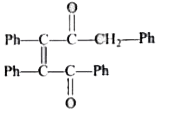What are the products expected in the following reactions?
C6H5−O∣∣C−CH2−O∣∣C−CH3CH2N2−−−→Ether
C6H5OCH3∣C=CH−O∣∣C−CH3
C6H5O∣∣C−CH=OCH3∣C−CH3
_S01_386_O03.png)
_S01_386_O04.png)
The correct Answer is:A, B
To determine the products expected from the reaction of the given compound with diazomethane in the presence of ether, we can follow these steps:
Step 1: Identify the Reactants
The reactant is a diketone compound represented as:
C6H5−C(=O)−CH2−C(=O)−CH3
This compound has a phenyl group (C6H5), two carbonyl (C=O) groups, and a methylene (CH2) group between them.
Step 2: Understand the Role of Diazomethane
Diazomethane (CH2N2) acts as a methylating agent. When it is treated with the diketone in ether, it undergoes cleavage to generate a reactive intermediate.
Step 3: Cleavage of Diazomethane
Upon heating, diazomethane undergoes homolytic cleavage to form a methylene carbocation:
CH2N2→CH+2+N2
This carbocation is a strong electrophile.
Step 4: Nucleophilic Attack
The methylene carbocation (CH2+) will seek a nucleophile to stabilize itself. In this case, the oxygen atoms from the carbonyl groups (C=O) act as nucleophiles. The nucleophilic attack will occur on one of the carbonyl carbons.
Step 5: Formation of Products
1. Product 1: When the methylene carbocation attacks the first carbonyl group (C=O), it leads to the formation of a new bond, resulting in:
C6H5−C(OH)−CH2−C(=O)−CH3
This product can further rearrange or lose a proton to stabilize.
2. Product 2: Alternatively, if the methylene carbocation attacks the second carbonyl group, the product will be:
C6H5−C(=O)−CH2−C(OH)−CH3
Again, this product can undergo rearrangement or proton loss.
Final Products
The final products of the reaction are:
1. C6H5−C(OH)−CH2−C(=O)−CH3
2. C6H5−C(=O)−CH2−C(OH)−CH3
Conclusion
Thus, the expected products from the reaction are:
- Product A: C6H5−C(OH)−CH2−C(=O)−CH3
- Product B: C6H5−C(=O)−CH2−C(OH)−CH3
The reactant is a diketone compound represented as:
C6H5−C(=O)−CH2−C(=O)−CH3
This compound has a phenyl group (C6H5), two carbonyl (C=O) groups, and a methylene (CH2) group between them.
Diazomethane (CH2N2) acts as a methylating agent. When it is treated with the diketone in ether, it undergoes cleavage to generate a reactive intermediate.
Upon heating, diazomethane undergoes homolytic cleavage to form a methylene carbocation:
CH2N2→CH+2+N2
This carbocation is a strong electrophile.
The methylene carbocation (CH2+) will seek a nucleophile to stabilize itself. In this case, the oxygen atoms from the carbonyl groups (C=O) act as nucleophiles. The nucleophilic attack will occur on one of the carbonyl carbons.
1. Product 1: When the methylene carbocation attacks the first carbonyl group (C=O), it leads to the formation of a new bond, resulting in:
C6H5−C(OH)−CH2−C(=O)−CH3
This product can further rearrange or lose a proton to stabilize.
C6H5−C(=O)−CH2−C(OH)−CH3
Again, this product can undergo rearrangement or proton loss.
The final products of the reaction are:
1. C6H5−C(OH)−CH2−C(=O)−CH3
2. C6H5−C(=O)−CH2−C(OH)−CH3
Thus, the expected products from the reaction are:
- Product A: C6H5−C(OH)−CH2−C(=O)−CH3
- Product B: C6H5−C(=O)−CH2−C(OH)−CH3
Topper's Solved these Questions
- ALKENE, ALKANE & ALKYNE Book:ALLENChapter:ALKENE, ALKANE & ALKYNE Exercise:EXERCISE-3
Explore 99 Videos
- ALKENE, ALKANE & ALKYNE Book:ALLENChapter:ALKENE, ALKANE & ALKYNE Exercise:EXERCISE-4(A)
Explore 10 Videos
- ALKENE, ALKANE & ALKYNE Book:ALLENChapter:ALKENE, ALKANE & ALKYNE Exercise:EXERCISE-1
Explore 119 Videos
- AIIMS 2019Book:ALLENChapter:AIIMS 2019Exercise:CHEMISTRY
Explore 40 Videos
- ALKYL AND ARYL HALIDEBook:ALLENChapter:ALKYL AND ARYL HALIDEExercise:EXERCISE-05 (B)
Explore 35 Videos
Similar Questions
Knowledge Check
H3C−CH3∣C∣CH3−H+CCl4R2O2−−→hvProduct :
AH3C−CH3∣C∣CH3−ClBCHCl3CBoth (a) and (b)DNone of theseFind the product of following reaction:
Ph−CH2−O∣∣C−CH2−Ph+Ph−O∣∣C−O∣∣C−PhNaOH−−−−−−→ΔA B
B C
C DNone of these
DNone of these
The products formed in the reaction are :
C6H5−O∣∣C−OH+CH318OHH2SO4−−−→Heat
View SolutionWrite the IUPAC names of the following compounds
(i) CH3−CH2−O∣∣C−CH2−O∣∣C−CH3
(ii) CH3−O∣∣C−CH2−CH2−CH2−CH2−COOH
(iii) CH3−CH∣C2H5−CH∣C2H5−CH3
View SolutionWhat would be the major products in the following reactions:
CH3−CH3∣C∣CH3−CH2BrC2H5OH−−−−→Δ
View SolutionWhat would be the major products in the following reactions:
CH3−CH3∣C∣CH3−CH2BrC2H5OH−−−−→Δ
View SolutionWhat would be the major products in the following reactions:
CH3−CH3∣C∣CH3−CH2BrC2H5OH−−−−→Δ
View SolutionWrite the product of following reactions :
(a) CH3−H3C∣C=CH3∣C−CH3O3−−−−−→Zn/H2O , (b) CH3−C≡C−CH3O3−−−−−→Zn/H2O
( c) CH3−C≡C−CH3O3/H2O2−−−−−→ , (d) CH3−CH3∣C=CH−CH3O3/H2O2−−−−−→
View Solution